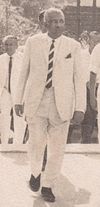Ceylonese parliamentary election, March 1960
|
|
||||||||||||||||||||||||||||||||||
|---|---|---|---|---|---|---|---|---|---|---|---|---|---|---|---|---|---|---|---|---|---|---|---|---|---|---|---|---|---|---|---|---|---|---|
|
||||||||||||||||||||||||||||||||||
|
151 seats to the House of Representatives of Ceylon 76 seats were needed for a majority |
||||||||||||||||||||||||||||||||||
|
||||||||||||||||||||||||||||||||||
|
||||||||||||||||||||||||||||||||||
Wijeyananda Dahanayake
Sri Lanka Freedom Party
Dudley Senanayake
United National Party
General elections were held in Ceylon (now Sri Lanka) on 19 March 1960.
By 1960, Ceylon's governing Mahajana Eksath Peramuna (MEP) coalition was falling apart. The Marxist parties that were junior partners of the coalition had broken with the dominant Sri Lanka Freedom Party over the issue of paddy lands. The Marxist Viplavakari Lanka Sama Samaja Party formed a new party that took the name MEP. The SLFP itself had been torn by an internal power struggle since the death of its leader, S.W.R.D. Bandaranaike, the previous year.
Both the United National Party and the SLFP campaigned on a strongly anti-Tamil line, promising to repatriate the estate Tamils to India, and implement the Sinhala Only Act.
Dudley Senanayake and the UNP obtained a plurality of seats, but without a majority could not form a stable government. This led to the July 1960 elections.
...
Wikipedia

